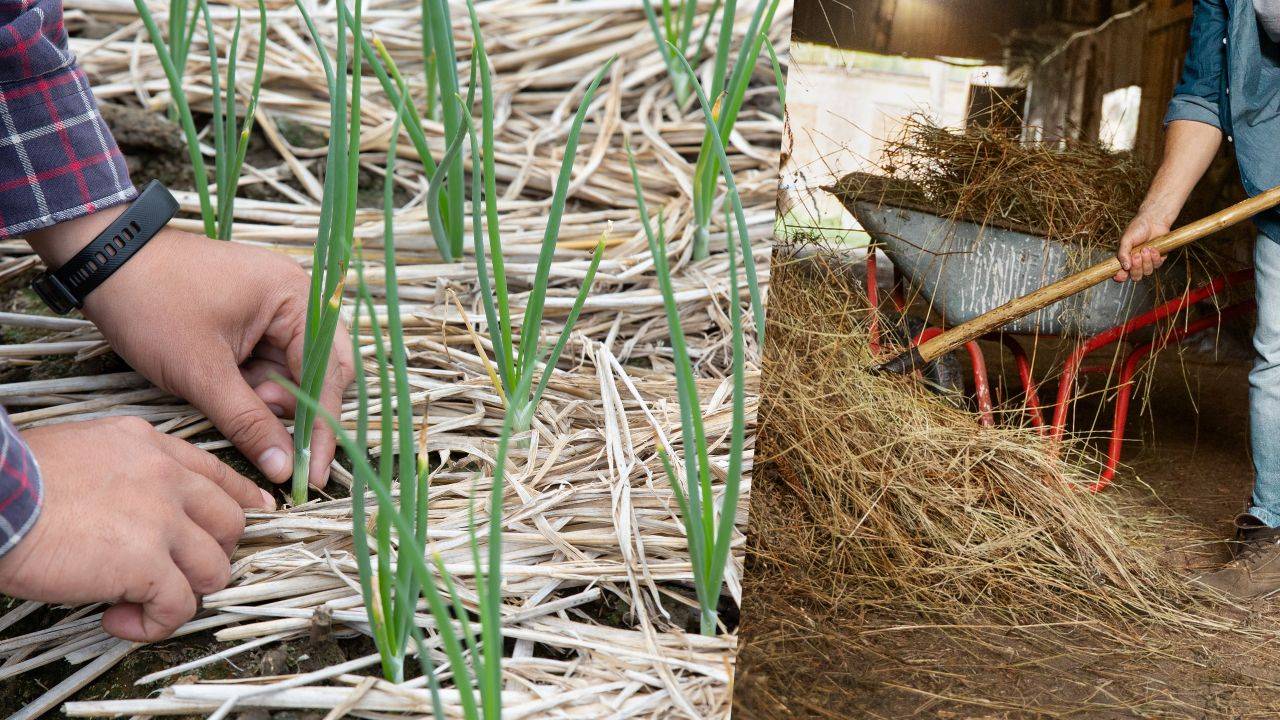
Straw mulch is a versatile and cost-effective gardening resource that can be used for various purposes, including starting a new lawn, planting a strawberry bed, and improving soil quality.
This natural product is made from flattened flakes of straw, which are tightly bound together with string. You can easily find straw mulch at home improvement stores, garden centers, and feed stores.
Straw mulch is a by-product of grain plants such as rye, barley, oats, rice, and wheat. After the grain and chaff are removed through a process called threshing, the leftover stalks are baled and sold for various applications, including mulching and animal bedding.
Using Straw Mulch
Straw mulch is particularly well-suited for lawns, vegetable gardens, and small fruit crops due to its practical benefits. However, its messy appearance makes it less suitable for ornamental flower beds, where aesthetics are a more significant consideration. Here are some key uses for straw mulch:
-
Vegetable Gardens
A small standard bale of straw can cover about 80 square feet with a 2-inch layer of mulch. Straw mulch helps with seed germination by maintaining soil moisture, making it ideal for spreading by hand in vegetable gardens. It can also be effectively used around established plants and is relatively lightweight.
Specific Uses
-
Under crops like squash, cucumbers, and melons, straw mulch keeps the fruits off the ground, preventing soft spots, molds, and rot in wet conditions.
-
For winter protection in strawberry beds, straw insulates the roots and keeps berries off the ground.
-
Adding a layer of straw around cool-weather crops like broccoli, cabbage, and cauliflower helps control soil temperature, slowing bolting and extending the growing season.
-
Straw mulch acts as a sunscreen around potato plants to prevent sun exposure, which can lead to the development of toxic substances like solanine.
-
Using straw mulch around fruits vulnerable to soil-borne diseases, such as tomatoes and peppers, helps limit disease spread caused by splash back.
-
Lawns
Straw is mainly used to mulch new lawns or make repairs. It helps retain moisture, supporting germination and allows young shoots to grow through it. Smaller lawns or spot repairs can be mulched by hand, while contractors often use machines called throwers for even distribution. As the lawn matures, the straw mulch breaks down with mowing, and any remaining mats or clumps can be manually removed and composted.
-
Landscape
While not visually appealing as a permanent mulch, straw can be used in landscaping for winter protection. Hydrangeas, roses, ornamental shrubs, young trees, and frost-tender plants benefit from a 3 to 4 inch layer of straw during the winter, which should be removed in the spring. For shrubs at risk of frost damage, creating a wire cage and packing it with straw can provide extra insulation.
Benefits of Straw Mulch
Straw mulch offers several advantages that make it a practical choice for your garden:
-
Inexpensive- Straw mulch is a budget-friendly option, making it accessible for gardeners of all levels.
-
Organic- It is a natural product without the use of synthetic chemicals, making it an eco-friendly choice.
-
Lightweight and Easy to Use- Straw bales are relatively easy to handle and distribute.
-
Nutrient-Rich- As straw mulch breaks down, it enriches the soil with nutrients, improving its overall quality.
-
Regulates Soil Temperature- Straw mulch helps moderate soil temperature, creating a more stable environment for plants.
-
Moisture Retention- It improves moisture retention and reduces evaporation, keeping your soil consistently hydrated.
-
Aerates Soil- Straw mulch can help aerate the soil, improving its structure over time.
-
Fruit Protection- It keeps fruits from direct contact with the soil, preventing issues like rot and mold.
-
Prevents Soil Crusting- Straw mulch helps prevent the formation of a hard crust on the soil surface.
-
Winter Protection- It offers valuable insulation during the winter months, protecting plants from harsh weather conditions.
Tips for Buying Straw Mulch
When purchasing straw mulch, consider the following tips:
-
Condition: Look for straw mulch that appears clean, dry, and odour-free, without signs of mold or excessive moisture. Proper storage is essential to maintain its quality.
-
Local Sources: Explore local sources for straw mulch, such as farmers who may offer baled straw after grain processing. This can provide you with information about the grain used and potentially better prices.
-
Uniformity: If you're buying multiple bales, opt for uniform size and shape, as this makes it less likely for the straw to mat and easier to handle. Check for even weight by giving each bale a slight lift.
Thus, straw mulch is a versatile, budget-friendly, and environmentally friendly option for various gardening needs. Whether you're tending to your vegetable garden, lawn, or protecting plants during the winter, straw mulch can be a valuable addition to your gardening toolkit.
















